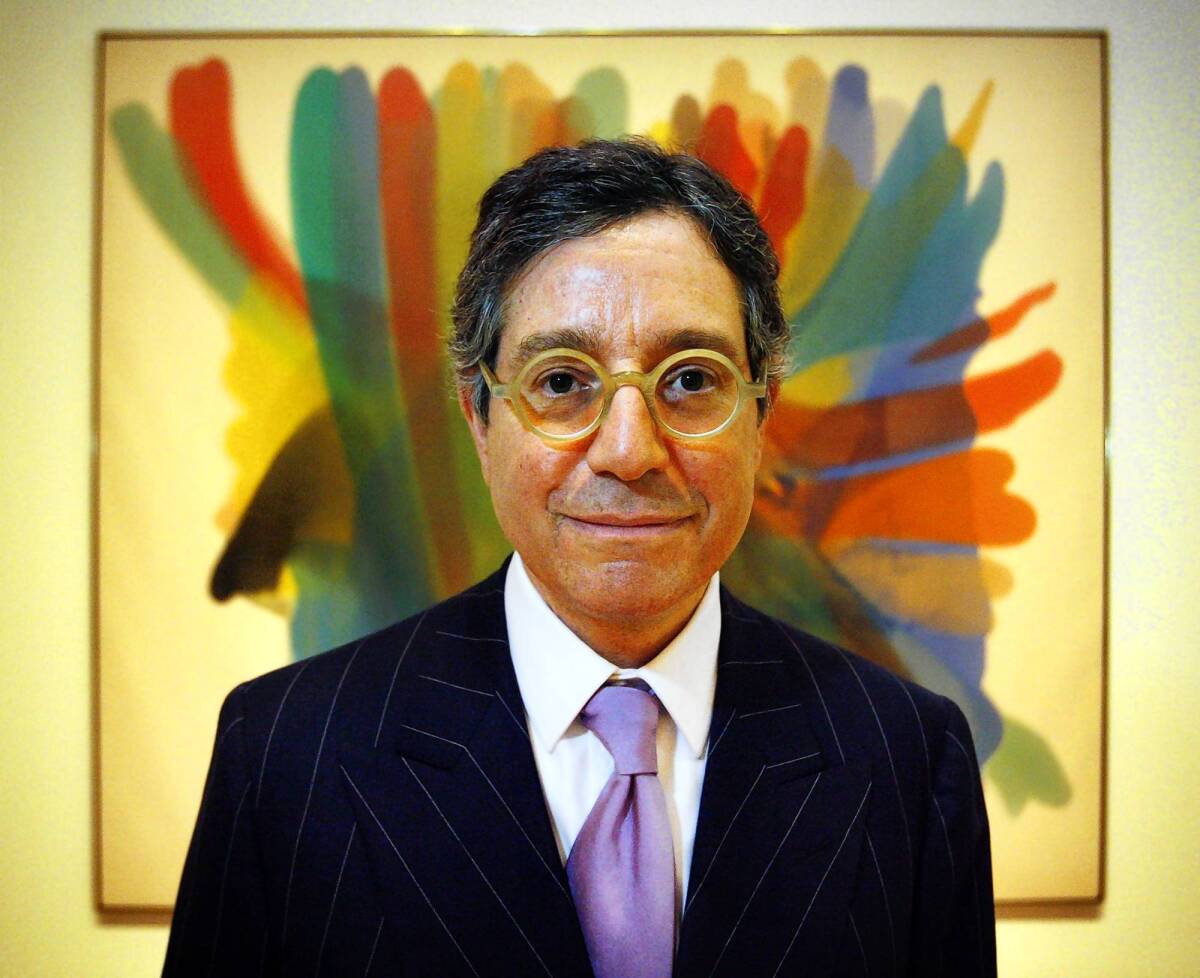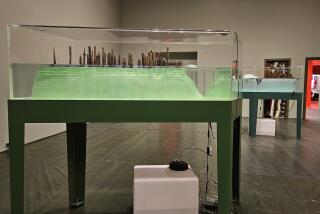MOCA and director Jeffrey Deitch as an oil-and-water mix

- Share via
The imminent departure of Jeffrey Deitch from the directorship of the Museum of Contemporary Art after three short years was never really a question of “if” but only “when.” The arrangement was bound to fail.
Rumors about the impending exit have swirled for months, reaching a crescendo in recent days. The MOCA board of trustees, which has remained silent through it all, is expected to make a major announcement after its regularly scheduled Wednesday meeting. It will surely put the best face on things.
But few are surprised at the outcome.
GRAPHIC: MOCA’s relationship with Jeffrey Deitch
When Deitch took the reins in June 2010, MOCA was in limbo. An internationally celebrated institution with arguably the finest program of any contemporary art museum in the nation had teetered on the brink of financial collapse, having been mismanaged for years.
The board’s confounding solution to the problem: Hire a new director with virtually no administrative museum experience, and empower him to change the program.
Except for a brief period in the 1970s, Deitch’s art career evolved inside the commercial world as an art dealer, investment advisor, gallery owner and consultant to private collectors. Outside of his New York gallery, Deitch Projects, occasional independent forays into writing and exhibition organizing largely took place in Europe. There, the not-for-profit world of art museums that distinguishes the United States is negligible.
The MOCA appointment appeared to be a first. A major gallery owner in New York, epicenter of the international art market, was being tapped for a prestigious museum post.
Museum directors traditionally come from within the curatorial and administrative museum ranks. That’s sensible, given the institutional complexity of a job that requires administrative skills to marshal the talents of a large staff; fundraising know-how for both short-term projects and long-term stability; an ability to work with professionals in the field, including artists, and the volunteers who make up the board and support groups; and a commitment to the art public in whose name the tax-exempt operation functions.
Deitch was untested in all of those areas. MOCA leaders framed their unprecedented decision as an example of the risk-taking for which an adventurous contemporary art museum had become widely admired. In reality, though, the choice just seemed naive.
The artistic difference between the two jobs is fundamental. A gallery owner can indulge a narrow and highly personal program — it’s his business, after all — while the best museum directors are those who merge a personal commitment with an eagerness to support gifted curatorial staff whose diverse, knowledgeable interests might even be contradictory. The liveliness of an art museum depends less on attendance figures than on the rambunctious discernment of disparate artistic ideas.
Obvious practical problems also loomed. One was the glaring fact that Deitch was an active art collector with considerable holdings in his own right. Museum professional associations caution against the collecting activities of staff. MOCA faced potentially messy commercial entanglements with its new director.
Deitch’s unfolding artistic program was regularly mischaracterized as celebrity-oriented and blandly populist, thanks to his indulgence in mostly wan exhibitions related to actors Dennis Hopper and James Franco, Hollywood tabloid photographer Weegee, iconic filmmaker Kenneth Anger, pop musician Mike D and, most of all, Andy Warhol and several of the late Pop artist’s progeny.
Instead, his program is better described as simply representing a belief that art culture and popular culture have merged, becoming one and the same.
PHOTOS: Arts and culture in pictures by The Times
The idea is contentious, yet it’s also just one among many competing notions in the argumentative arena of contemporary art. Suitable for a commercial gallery, it’s nothing to build an ambitious museum program around. But the opportunity to attempt it proved irresistible to the untried gallery owner.
Emblematic was “Art in the Streets,” the 2011 exhibition of graffiti and street art that was a hit at MOCA’s Little Tokyo warehouse space. The crowds who came — and who mostly did not return, as is typical for ingratiating, one-off blockbusters — saw an often engaging array of work familiar from day-to-day encounters outside the museum.
But the show’s concept was seriously flawed. Making no discernible distinction between graffiti, the outlaw tagging that first flourished in 1970s New York, and considered street art in the form of epic murals and other works that prospered simultaneously in Los Angeles and elsewhere, the exhibition seemed provincial and ill-informed.
The show also represented inroads into a disturbing development. Curatorial staff had built MOCA’s reputation as an innovative museum over several decades, but now, guest curators with no museum ties were brought in to organize the program. Less expensive because they are retained only on a project basis, the curators frequently had financial relationships with the art and artists being shown that raised the inescapable specter of conflicts of interest.
SUMMER TRIPS: Guidebook takes you to America’s sculpture gardens
Outsourcing, a business trend that has bedeviled the struggling American economy, was being imported into the nonprofit art museum. Staff positions throughout the museum had become something of a revolving door, but in diminishing the institution’s core curatorial function, MOCA saw its reputation dwindle. When Paul Schimmel, the chief curator who led the program staff for 22 years, was dumped last summer, a Rubicon was crossed.
The news was delivered to Schimmel by MOCA life trustee Eli Broad rather than Deitch, whose job as director required it. By then it was clear, if it hadn’t been already, that a museum board that had failed in its responsibilities for fiduciary oversight in the run-up to MOCA’s near collapse in the fiscal crisis of 2008 was failing still.
Whether or not that will continue remains to be seen. In recent weeks, MOCA trustees have been sounding out potential candidates to succeed Deitch among European museum professionals. Given publicity around MOCA’s difficult five years, the American museum pool has been tainted; austerity budgets at European museums, where government funding is more common, might make the grass look considerably greener across the Atlantic.
The best news is that MOCA’s endowment fundraising, led by trustees Jeffrey Soros and Eugenio Lopez, is pegged at more than $75 million in pledges, with a goal of $100 million in sight. That will be the floor, rather than the ceiling, of what the museum will require in the post-Deitch era.
Skillful fundraising will need to be undertaken by whoever becomes director. But the labor of rebuilding a once stellar museum from scratch might at least be approached as a golden opportunity.
More to Read
The biggest entertainment stories
Get our big stories about Hollywood, film, television, music, arts, culture and more right in your inbox as soon as they publish.
You may occasionally receive promotional content from the Los Angeles Times.











